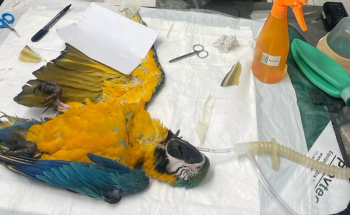
Infectious diseases of captive reptiles (Proceedings)
The rise in popularity of herpetoculture over the past two decades has led to an increased number of reptiles being imported and captive reared to meet the demands of herpetoculturists.
The rise in popularity of herpetoculture over the past two decades has led to an increased number of reptiles being imported and captive reared to meet the demands of herpetoculturists. With this influx of animals has come an increase in the number of pathogens being reported. Some of these pathogens have been around for some time, while others are novel and are only recently being described.
The successful management of infectious diseases in the reptile cases presenting to our practices depends on a thorough and consistent evaluation of our patients. Fortunately, the number of diagnostic tests available to the clinician treating reptiles has increased dramatically over the past twenty years. Historically, clinicians treated all "infections" in reptiles as bacterial diseases. However, over the past twenty years, there have been an increased number of reports of viruses and fungi being isolated from diseased reptiles. The advent of molecular diagnostic testing has led to the development of highly sensitive and specific enzyme-linked immunosorbent assays, polymerase chain reaction (PCR), and reverse-transcriptase PCR. The purpose of this presentation is to provide attendees a review of common infectious diseases being reported in captive reptiles, along with the methods for diagnosing and treating these pathogens.
Cryptosporidium serpentis is considered a "plague" of captive snake collections. This apicomplexan parasite has been associated with both high morbidity and mortality in captive collections. Affected snakes commonly regurgitate their meals, have a mid-body swelling, and are dehydrated. A variety of methods may be used to diagnose cryptosporidiosis in snakes. Acid-fast cytology of a regurgitated meal or fecal sample is often diagnostic. Because there is currently no effective treatment, affected animals should be culled. Cryptosporidium saurophilum is a more recently diagnosed species associated with lizards. Whereas C. serpentis is associated with the stomach, C. saurophilum is associated with the intestine. Currently, no consistent treatment is available for C. saurophilum or C. serpentis.
Coccidiosis is a major cause of morbidity and mortality in reptiles. A species of special concern, Isospora amphiboluri, is found in bearded dragons. These endoparasites are especially problematic in neonatal dragons, often resulting in stunting, diarrhea, and death. Whereas most coccidial infections in higher vertebrates are self-limiting, these infections often persist in bearded dragon colonies. Historically, eliminating coccidia from bearded dragons was difficult because most of the therapeutics used to eliminate the parasites were coccidiostatic. Ponazuril (30 mg/kg per os once with a second treatment 48 hours later) is coccidiocidal and has excellent therapeutic value against I. amphiboluri. Quarantine and environmental disinfection/sanitation should also be done to eliminate coccidia from dragon colonies.
Microsporidians are obligate intracellular parasites. The life cycle of these parasites includes both merogenic and sporogenic phases. These parasites are common in lower vertebrates (e.g., fish), but have also been implicated as a concern in humans with acquired immunodeficiency virus. Bearded dragons infected with these parasites can present with a similar clinical picture as adenovirus or coccidiosis. Affected dragons are anorectic, unthrifty, cachectic, and may die acutely. Diagnosis is generally made at post-mortem. Hepatic and renal necrosis is common, although other organ systems (e.g., intestine and gonads) may also be affected. There is no effective treatment. To limit the likelihood of introducing this parasite into a collection, herpetoculturists should only acquire animals from reputable breeders and quarantine any new arrivals for a minimum of 60-90 days.
Mycoplasmosis is a bacterial infection that has been associated with severe disease in chelonians. Affected animals may present with nasal and ocular discharge, conjunctivitis, palpebral edema and pneumonia. Mycoplasmosis has also been identified in squamates and crocodilians. There are several diagnostic tests available to confirm mycoplasmosis in reptiles, including culture, an ELISA and a PCR assay. Microbiologic culture can be used to confirm an infection, but it is difficult to isolate this bacteria and time consuming. Currently, parallel testing using both the ELISA and PCR assays provides the highest degree of sensitivity. Treatment may be attempted using tetracyclines and fluoroquinolones. Mycoplasmosis has been associated with declines in native tortoise populations in the United States and treatment of wild specimens is not recommended.
The incidence of herpesvirus infections in chelonians has been on the rise since originally being isolated from sea turtles in 1975. Herpesvirus infections have been identified in freshwater, marine, and terrestrial species of chelonians. Transmission of the herpesvirus is believed to be via the horizontal route, although it has been suggested that a vertical route of transmission is also possible. Affected animals may present with rhinitis, conjunctivitis, necrotizing stomatitis, enteritis, pneumonia, and neurological disease. Molecular diagnostics, electron microscopy, and viral isolation have been used to diagnose herpes infections in chelonians. Affected animals should be provided appropriate supportive care (e.g., fluids, enterals, and antibiotics) to control clinical signs. Acyclovir has been used with some success by reducing viral replication. However, there is no effective treatment for this virus. Affected animals should not be released into the wild to prevent translocation of the virus to naïve chelonians.
Bearded dragon adenovirus was first reported in Australia in the early 1980's. The virus was not characterized in the United States until more than a decade later. Since that time, the virus has spread through the bearded dragon population in the USA and should be considered endemic. Transmission of the virus is primarily by the direct route (fecal-oral), although vertical transmission may also be possible. Affected animals may present with anorexia, weight loss, limb paresis, diarrhea and opisthotonous. Concurrent dependovirus and coccidial infections have also been observed in neonatal bearded dragons. Biopsies of the liver, stomach, esophagus, and kidney may be collected to confirm diagnosis (ante-mortem). On histopathology, basophilic intranuclear inclusion bodies are strongly suggestive of adenoviral infection. Currently, there is no non-invasive ante mortem diagnostic test to confirm adenovirus in the reptile; however, the author is currently working on a polymerase chain reaction (PCR) assay to detect adenovirus in the feces of affected animals. There is no effective treatment for adenoviral infections, although supportive care (e.g., fluids, enterals, antibiotics) may be useful in stemming the secondary effects of the disease. Again, very little is known regarding the epidemiology of this virus; therefore, special precautions should be taken when working with affected animals. Because there is no effective treatment, affected bearded dragons should be culled from breeding populations.
Newsletter
From exam room tips to practice management insights, get trusted veterinary news delivered straight to your inbox—subscribe to dvm360.






